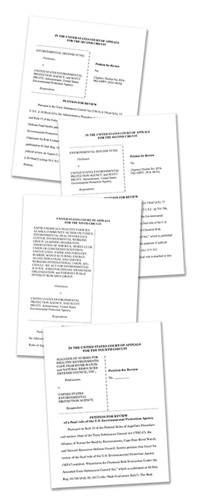Advertisement
Grab your lab coat. Let's get started
Welcome!
Welcome!
Create an account below to get 6 C&EN articles per month, receive newsletters and more - all free.
It seems this is your first time logging in online. Please enter the following information to continue.
As an ACS member you automatically get access to this site. All we need is few more details to create your reading experience.
Not you? Sign in with a different account.
Not you? Sign in with a different account.
ERROR 1
ERROR 1
ERROR 2
ERROR 2
ERROR 2
ERROR 2
ERROR 2
Password and Confirm password must match.
If you have an ACS member number, please enter it here so we can link this account to your membership. (optional)
ERROR 2
ACS values your privacy. By submitting your information, you are gaining access to C&EN and subscribing to our weekly newsletter. We use the information you provide to make your reading experience better, and we will never sell your data to third party members.
Policy
Revisiting Chemical Control Law
Congress scrutinizes Toxic Substances Control Act with an eye toward reforming the statute
by Cheryl Hogue
March 9, 2009
| A version of this story appeared in
Volume 87, Issue 10

FOR MORE THAN three decades, the U.S. law governing commercial chemicals has remained essentially unchanged. Despite criticism—especially after a federal court in 1991 struck down under that law the Environmental Protection Agency's ban of the known human carcinogen asbestos—Congress has not seen fit to revise the statute.
The chemical industry for years maintained that the 1976 Toxic Substances Control Act (TSCA) worked well to protect health and the environment. Environmental activists and the Government Accountability Office (GAO), the investigative arm of Congress, meanwhile, have complained that the law leaves EPA without the information it needs to assess chemicals' risk. In addition, they say EPA is virtually powerless to regulate substances that are problematic. Elected leaders have left TSCA untouched.
Now, the situation is changing.
Congressional scrutiny of this law is ramping up. Rep. Henry Waxman (D-Calif.), chairman of the House Energy & Commerce Committee, is putting TSCA under a magnifying glass and intends to push legislation reforming the chemical control law. Waxman took over leadership of the powerful committee late last year after winning a political turf battle and displacing the industry-friendly former chairman, Rep. John Dingell (D-Mich.). Unlike Dingell, Waxman is pushing for changes to TSCA. In 2008, Waxman cosponsored a bill to overhaul the statute.
On Feb. 26, the Energy & Commerce Subcommittee on Commerce, Trade & Consumer Protection held the first in what panel Chairman Bobby L. Rush (D-Ill.) said will be a series of hearings on TSCA.
At that hearing, the chemical industry endorsed a congressional review of the law and agreed some changes are needed. The industry is united on one point: The U.S. should not adopt a system like the European Union's program for Registration, Evaluation, Authorization & Restriction of Chemical substances (REACH).
"It is clear that the public, for a variety of reasons, does not have confidence that the regulatory system is adequately ensuring the safety of the products they use," Calvin M. Dooley, president and chief executive officer of the American Chemistry Council, testified at the hearing. ACC, a trade association of large chemical manufacturers, is now actively calling for Congress to modernize TSCA. It is urging Congress to institute authority for EPA to determine whether chemicals are safe for their intended uses. Currently, EPA examines the risks posed by chemicals but does not deem them safe or unsafe.
Meanwhile, the industry group Synthetic Organic Chemical Manufacturers Association contends that TSCA doesn't need a complete overhaul. V. M. (Jim) DeLisi, president of Fanwood Chemical, who testified on behalf of SOCMA at the hearing, said the law "could be enhanced to meet new challenges." Likewise, Charles T. Drevna, president of the industry group the National Petrochemical & Refiners Association, told the subcommittee, "I do not believe a wholesale rewrite is necessary," especially not one that resembles REACH.
Industry representatives blamed many of the problems with TSCA on lack of federal funding for the EPA program that implements it.
BUT ENVIRONMENTAL activists, policy analysts, and GAO say the problems with TSCA are much more complicated than simply lack of funding and stem mainly from provisions in the current law.
A main target of their attention is the legal requirements that EPA must fulfill before it can restrict or ban a chemical under TSCA. The statute requires the agency to prove that a substance presents an unreasonable risk of harm to human health or the environment before it can regulate that chemical in commerce. Advocates of TSCA reform want Congress to relax this hard-to-meet standard.
Current requirements "make it practically impossible for EPA to regulate existing chemicals," which are substances that are already on the market as opposed to new ones, according to J. Clarence Davies, who in the 1970s drafted the original version of the legislation that became TSCA. Davies, a senior adviser at the Woodrow Wilson International Center for Scholars and a senior fellow at Resources for the Future, an environmental and energy policy think tank, testified at the Feb. 26 hearing and said his views were his own and not those of the organizations for which he works.
Echoing Davies' point, Richard A. Denison, senior scientist with the activist group Environmental Defense Fund, told the subcommittee that it took EPA more than a decade to amass 45,000 pages of documents supporting its ban on asbestos. Yet a federal court ruled that EPA failed to show that asbestos posed an unreasonable risk.
In its 1991 decision, the U.S. Court of Appeals for the 5th Circuit faulted EPA for failing to show that the asbestos ban was the least burdensome regulation required to adequately protect human health or the environment, as TSCA requires, John B. Stephenson, director of natural resources and the environment at GAO, testified at the hearing. EPA has not tried to ban or otherwise limit existing chemicals since that court decision.
Another issue targeted by advocates of a major TSCA rewrite is a provision protecting information that industry provides to EPA and claim as a trade secret. Evaluating assertions of confidentiality takes time and money, Stephenson said, "and as a result, EPA does not challenge most claims."
TSCA forbids EPA to share proprietary information. This provision is a major impediment to U.S. cooperation on chemical regulation both internationally and with states, Davis said.
Meanwhile, those seeking wholesale changes to TSCA point to EPA's need to obtain toxicity information about chemicals. Before it can use this law to compel chemical makers to run laboratory tests and generate data, EPA must spend years and hundreds of thousands of federal dollars to issue formal regulations.
The agency, however, faces a Catch-22 when issuing this sort of regulation, according to Denison of Environmental Defense Fund. "EPA must already have information sufficient to document potential risk or extensive exposure to require a company to test its chemical to determine whether there is actual risk," he said.
This situation demonstrates that "TSCA generally places the burden of obtaining data on chemicals on EPA, rather than on the companies," Stephenson said. During TSCA's 33-year history, the agency has issued formal regulations to obtain information for only about 200 of the tens of thousands of chemicals currently on the market, he noted.
TO GET TOXICITY information about chemicals other than by issuing regulations, EPA has resorted to voluntary efforts. In 1998, the agency, ACC, and Environmental Defense Fund launched an initiative to generate and make public toxicity data on more than 2,500 organic compounds made or imported in amounts of 1 million lb or more per year. EPA is using the information, along with other data about exposure, to screen chemicals and determine which deserve greater scrutiny by regulators. The 11-year-old program, which lacks enforceable deadlines, has not yet collected all the data EPA says it needs (C&EN, June 9, 2008, page 33). And Environmental Defense Fund, which is closely tracking these voluntary industry submissions, says some of the data are incomplete or of poor quality.
Bulk commercial chemicals aren't the only TSCA-regulated materials for which EPA needs information. The agency also uses this law to regulate nanomaterials and synthetic microorganisms, which are made from laboratory-designed genetic sequences. But TSCA does not give EPA adequate authority, Davis said, to gather the data it needs to assess risks from these innovative products.
"There is a large mismatch between the current regulatory system and the characteristics of 21st-century science and technology," Davies commented.
As the House Energy & Commerce Committee continues to examine TSCA, Republicans on the panel are calling for caution. For instance, Rep. George Radanovich (R-Calif.) said any revisions to TSCA should be "surgical."





Join the conversation
Contact the reporter
Submit a Letter to the Editor for publication
Engage with us on Twitter